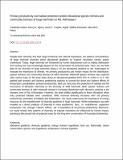| dc.description.abstract | Despite their diversity and their large functional and cultural importance, the patterns and predictors of large mammal diversity along elevational gradients on tropical mountains remain poorly understood. Today, large mammals are threatened by human disturbances such as habitat destruction and hunting and may increasingly depend on the conservation of protected areas. Here, we use field data on the diversity of large mammals along a 3.6 km elevational gradient on Mt. Kilimanjaro to evaluate the importance of climate, net primary productivity and human impact for the distribution, species richness and community biomass of wild mammals. Mammal species richness was explored with camera traps on 66 study plots along an elevational gradient from 870 to 4,550 m a.s.l.. We applied path analysis and variance partitioning analysis to unravel the direct and indirect effects of temperature, precipitation, primary productivity, land use, land area, the protection of habitats and the occurrence of domestic mammals on the diversity of wild mammals. Both species richness and community biomass of wild mammals showed a unimodal distribution with elevation, peaking in the montane zone of Mt. Kilimanjaro. However, the peak shifted significantly to lower elevations when only protected habitats were considered. Wild mammal diversity increased with net primary productivity, protection of habitats and temperature. Our study underscores the importance of energy resources for the establishment of diversity gradients in large mammals. While temperature has been revealed as a direct predictor of diversity in most ectothermic taxa, in endothermic organisms temperature has stronger indirect effects, via a modulation of net primary productivity. Moreover, our study reveals how patterns of diversity on tropical mountains are influenced by human impact, pointing to the pivotal role of protected areas for the long-term conservation of mountain biodiversity. | en_US |

